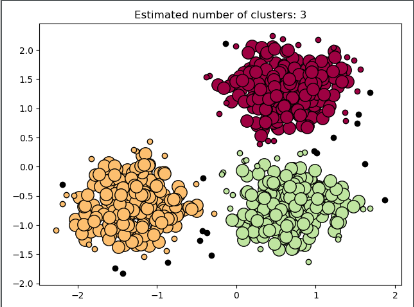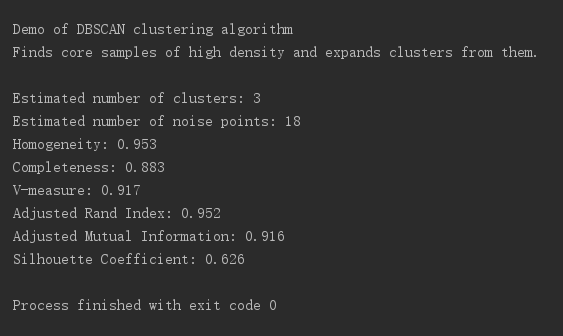发现高密度的核心样品并从中膨胀团簇。
Python代码如下:
1 # -*- coding: utf-8 -*- 2 """ 3 Demo of DBSCAN clustering algorithm 4 Finds core samples of high density and expands clusters from them. 5 """ 6 print(__doc__) 7 # 引入相关包 8 import numpy as np 9 from sklearn.cluster import DBSCAN 10 from sklearn import metrics 11 from sklearn.datasets.samples_generator import make_blobs 12 from sklearn.preprocessing import StandardScaler 13 import matplotlib.pyplot as plt 14 # 初始化样本数据 15 centers = [[1, 1], [-1, -1], [1, -1]] 16 X, labels_true = make_blobs(n_samples=750, centers=centers, cluster_std=0.4, 17 random_state=0) 18 X = StandardScaler().fit_transform(X) 19 # 计算DBSCAN 20 db = DBSCAN(eps=0.3, min_samples=10).fit(X) 21 core_samples_mask = np.zeros_like(db.labels_, dtype=bool) 22 core_samples_mask[db.core_sample_indices_] = True 23 labels = db.labels_ 24 # 聚类的结果 25 n_clusters_ = len(set(labels)) - (1 if -1 in labels else 0) 26 n_noise_ = list(labels).count(-1) 27 print('Estimated number of clusters: %d' % n_clusters_) 28 print('Estimated number of noise points: %d' % n_noise_) 29 print("Homogeneity: %0.3f" % metrics.homogeneity_score(labels_true, labels)) 30 print("Completeness: %0.3f" % metrics.completeness_score(labels_true, labels)) 31 print("V-measure: %0.3f" % metrics.v_measure_score(labels_true, labels)) 32 print("Adjusted Rand Index: %0.3f" 33 % metrics.adjusted_rand_score(labels_true, labels)) 34 print("Adjusted Mutual Information: %0.3f" 35 % metrics.adjusted_mutual_info_score(labels_true, labels, 36 average_method='arithmetic')) 37 print("Silhouette Coefficient: %0.3f" 38 % metrics.silhouette_score(X, labels)) 39 # 绘出结果 40 unique_labels = set(labels) 41 colors = [plt.cm.Spectral(each) 42 for each in np.linspace(0, 1, len(unique_labels))] 43 for k, col in zip(unique_labels, colors): 44 if k == -1: 45 col = [0, 0, 0, 1] 46 class_member_mask = (labels == k) 47 xy = X[class_member_mask & core_samples_mask] 48 plt.plot(xy[:, 0], xy[:, 1], 'o', markerfacecolor=tuple(col), 49 markeredgecolor='k', markersize=14) 50 xy = X[class_member_mask & ~core_samples_mask] 51 plt.plot(xy[:, 0], xy[:, 1], 'o', markerfacecolor=tuple(col), 52 markeredgecolor='k', markersize=6) 53 plt.title('Estimated number of clusters: %d' % n_clusters_) 54 plt.show()
测试结果如下:
最终结果绘图:

具体数据:
